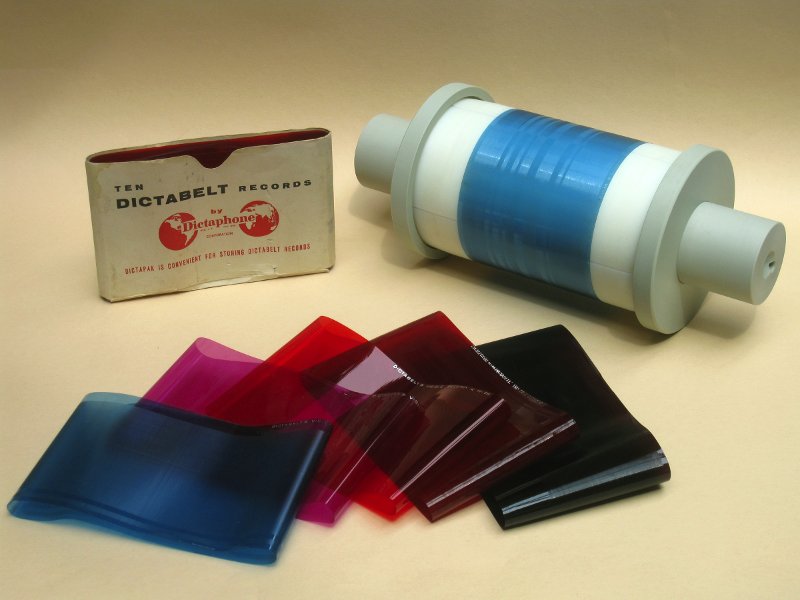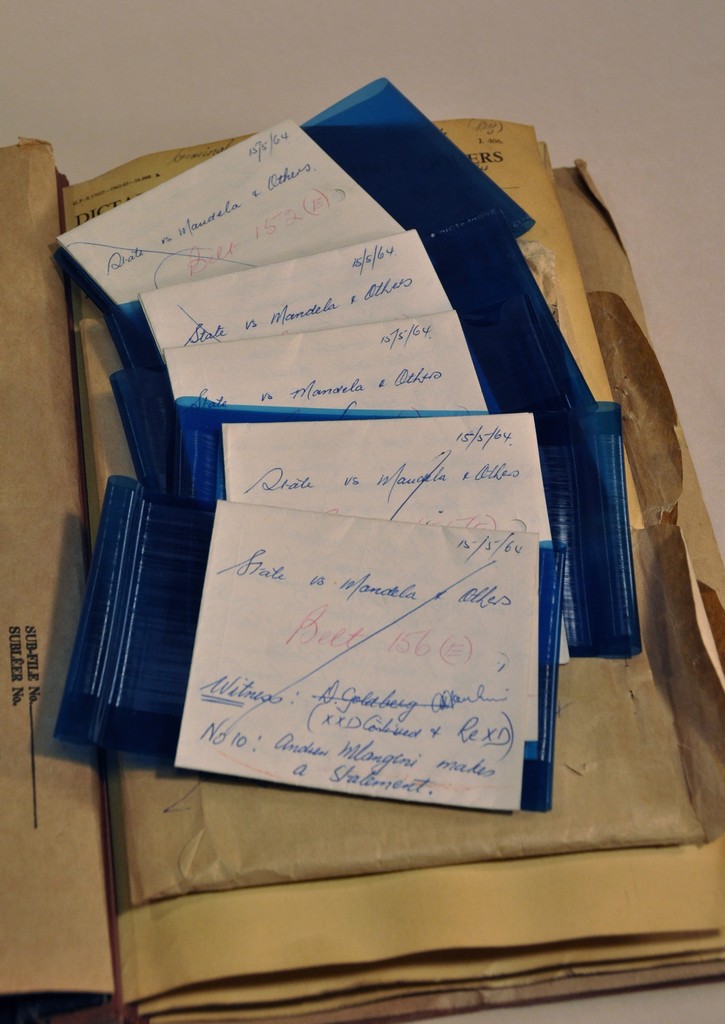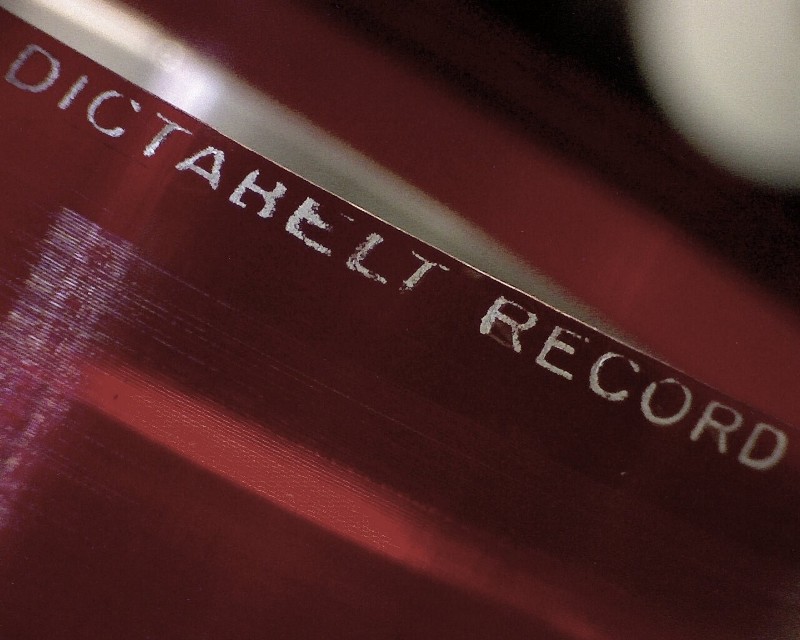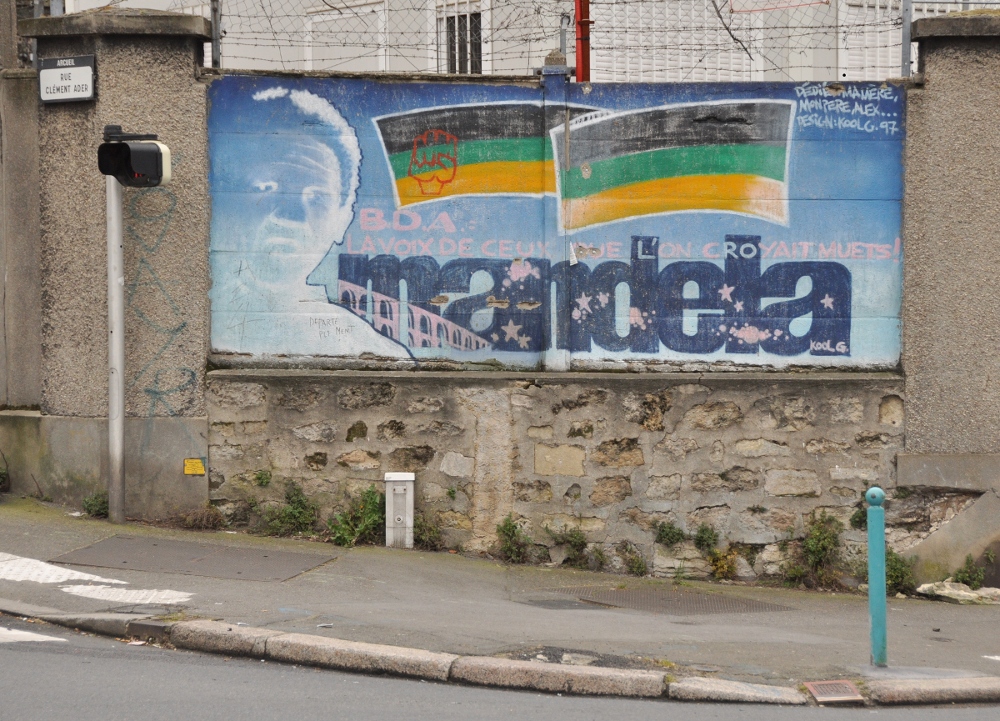Also available to download, Henri
CHAMOUX : Digitizing the Rivonia trial dictabelts with the
Archeophone phonograph, pdf of the
slideshow presented at the conference Listening to the
Rivonia Trial: Courts, Archives and Liberation Movements,
Johannesburg - University of the Witwatersrand, 27 September 2018.
A singular figure among the last cylinders used for sound carriers, the
dictabelt is a thin floppy cylinder made of vinyl, red, blue or purple in
color stretched between two rollers and set in rotation in a dictaphone
machine. Also called tank tread or memobelt, the dictabelt was of common
use in the USA for the most part, but also in other countries from 1947 to
the late 1970s. A versatile cylinder during the Cold War, it had a few
well-known applications, such as the recording of telephone conversations
of President Kennedy, the integral dictation of a novel by writer Agatha
Christie when she was too old to write by hand, or the recording of the
Rivonia trial (1963-1964). This trial is a landmark in South Africa’s
fight for freedom: It was a trial in which Nelson Mandela together with
Walter Sisulu, Govan Mbeki, Raymond Mhlaba, Elias Motsoaledi, Denis
Goldberg, Andrew Mlangeni and Ahmed Kathrada were accused of trying to
overthrow the state and ended in all the above being sentenced to life
inprisonment. During the trial, no discussions were taken down on paper.
Instead, the proceedings were recorded on 591 dictabelts.
In December 2006 these were inscribed on UNESCO's Memory
of the World register. These precious
documents were loaned to the Ina (Institut national de l'audiovisuel) in
October 2014 by the National Archives of South Africa (NARSSA) where they
will be returned soon.
I am a French civil servant working for the Rhône-Alpes Historical
Research Unit (
LARHRA,
a joint research unit of the CNRS). I am also the inventor of the «
Archéophone» phonograph
(1998) and it is with this device that I digitized the Rivonia dictabelts
alone. The recording and editing took place over a 15 month period and
totaled about 230 hours of recording. My specific expertise on cylinder
reproduction and transfer made an agreement possible between LARHRA and
Ina in November 2014, so as to allow the digitization of the Rivonia trial
dictabelts to be processed in the best technical conditions. Coordination
of the project was carried by Brice Amouroux at Ina, but a key link
between our institutions has been Patrick Louvet, expert in the field of
rare audio carriers, who also led the digitization quality control.
It is to be noted that among these 591 dictabelts, both blue and red in
color, the seven blue ones recorded by Nelson Mandela himself (Statement
from the dock, 20 April 1964) had already been
digitized in 2001 at the British Library in London. This had been carried
out with methods that were both crude and sophisticated, such as using a
modified vintage portable Dictabelt player.
This was placed on an industrial hotplate in order
to smooth out the creases and allow playback with minimal
groove-jumping... The purpose here is not to blame the British Library but
the fact is that two of those seven dictabelts are now damaged and bear
huge scratches with locked grooves which seldom appear anywhere else in
the whole collection. Such damage is typical of mishandling on vintage
machines and could have been done during uneven attempts made before or
after these documents were in the hands of BL agents.
While it appears possible to play a few dictabelts correctly using vintage
machines, the reliability is jeopardized as soon as numerous playbacks of
sensitive archives are required.
Beginning
with the make of a solid mandrel made available in 2007 I developed
an adjustable diameter mandrel designed to play dictabelts like cylinders
on the archéophone phonograph : this was achieved in 2013. A tightness
gently added to the jaws of this special mandrel on the whole length of
the dictabelt allows for a considerable reduction of the creases or
clicking problems, and this without any squashing of the dictabelt and
without the need to heat it in order to soften or loosen the vinyl.
Consequently the document is not damaged.
As the first listener of the whole set, I recently lived every minute of
the Rivonia Trial or at least what was recorded of it : straining my ears
on these dialogues in English, checking at each instant the correct
progression of the groove, was a unique experience. From some points of
view, it was similar to many other trials : while hearing the deep and
quiet tone of judge Quartus de Wet (1899-1980) who rarely speaks, compared
to the voice of attorney-general Percy Yutar (1911-2002) who is heard at
every moment with a specific exaggerated tone crescendo at the very end of
each of his questions. Yet this audition was mostly a highly emotional
one, discovering each voice in turn, especially the voices of numerous
second rank witnesses, some of them being absolutely terrified. On the
other hand while listening to the voices of the principal people on trial
and their patient answers and statements, one can actually feel how,
together, these voices strongly transformed this trial into a tribune for
equality against apartheid. For instance one could enumerate the
occurrences of such sentences as : "
I am
not prepared to disclose any of my friends", pronounced by Ahmed
Kathrada and by Walter Sisulu and others, just to prove again, with the
added force of actual voices this time, the strength and value of the
exceptional people there.
There is no final verdict to be heard : despite the fact that these are
complete sessions recorded in their continuity - mornings and/or
afternoons - on two machines which were appropriately relayed with no loss
or blank, the whole trial is not recorded here. The last audio recording
was made on the 18th of May, 1964, a few weeks before the verdict
was formally rendered (12th June, 1964). Rivonia's Dictabelts are not
stored in their eight albums in a strict chronological order, and the
whole collection appears mainly a series of formal questioning. One will
not find the opening sessions either : nothing like "oyez ! oyez !" or any
other traditional interjection usually launched in order to introduce an
opening, but only short microphone tests or what sounds like folding seats
or swing doors and noises of chairs moving while everybody stands up. This
trial officially began on the 26th November, 1963, but the very first
recording dates from the 29th, beginning with an ongoing quashing of
indictment procedure or discussion.
Despite the presence of numerous cracks and other imperfections, the
entire collection is already quite audible, loud and clear, but it still
needs to be restored, this work being done by Vincent Fromont, an audio
restorer at Ina. Once done, a copy of the whole audio material will be
made available in the future to researchers, students and teachers in all
disciplines, for local consultation at the
Ina-THEQUE.
Of course, South Africa will be at liberty to broadcast and give
unrestricted access and visibility to this milestone in its history.
See also :
-
Bringing
Mandela’s Voice Back to Life (Philippe Nessmann,
CNRS
News, May 19, 2016)
-
Mandela
trial : audio archives digitized thanks to the LARHRA and the
Archeophone (ENS de Lyon,
News and Events, May 1,
2016)
- The
Dictabelt, a recording medium of the 1950's (video,
Patrick Louvet, Henri Chamoux, Amédiart, 2014)
- The
digitization of the Rivonia trial dictabelts (video,
Roddy Cunningham, 2015)
-
Hand
over of Rivonia Trial digitised files is historic (video,
Minister Nathi Mthethwa, Laurent Vallet, SABC, March 17, 2016)
-
Handover of the Rivonia Trial dictabelts
to the French Government (French Embassy in Pretoria,
October 10, 2014)
-
Return of the digitised Rivonia Trial
tapes to South Africa (French Embassy in Pretoria, March
17, 2016)
-
The
Rivonia trial records go digital (Motlagae Konyana, KayaFM
- Home of the Afropolitan, September 28, 2018)
-
Archeophone
brings life back to Rivonia trial recordings (Luvuyo Mdeni,
SABC News, September 27, 2018)
Other
articles
here (in French).
Audio excerpts
(unrestored)
Nelson Mandela starts speaking (20 April
1964) : end of opening remarks by defense attorney Bram Fischer;
microphone is moved to the dock, Nelson Mandela starts speaking and is
interrupted by Prosecutor Percy Yutar's last intervention and answer
by judge Quartus de Wet; Nelson Mandel, beginning of his statement
from the dock
To
listen
Nelson Mandela lists the names of heads of
state who received him during his African tour as a delegate of the
ANC. This exit without a permit from the territory of South Africa was
the main reason for the five-year sentence he was already serving
during the Rivonia Trial.
To
listen
- Defending himself to be a communist,
Nelson Mandela says his veneration to the Magna Carta
(1215), the Petition of Right
(1628), the Bill of Rights
(1689), showing his great respect and admiration to the most
democratic institutions (20 April 1964).
To
listen
- Last words in Nelson Mandela's statement
: "During my lifetime I have
dedicated myself to this struggle of the African people. I have
fought against white domination, and I have fought against black
domination. I have cherished the ideal of a democratic and free
society in which all persons live together in harmony and with equal
opportunities. It is an ideal which I hope to live for and to
achieve. But if needs be, it is an ideal for which I am prepared to
die." (20 April 1964).
To
listen
- Walter Sisulu tells about his travels in
Eastern Europe and develops on the role of ANC (20 April 1964).
To listen
- Ahmed Kathrada tells about his travels to
Europe and his visit to Auschwitz (26 April 1964).
To
listen





